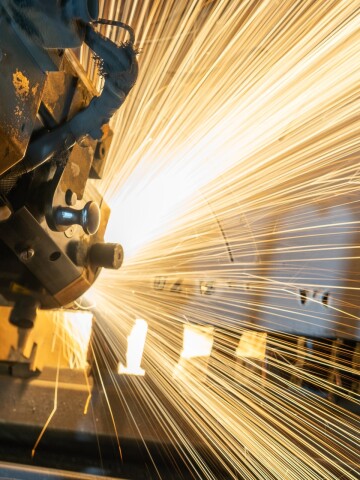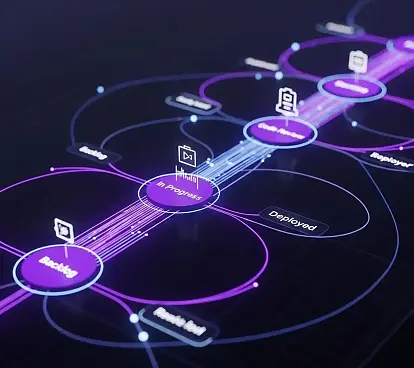
The technological transformation of the manufacturing industry
September 20, 2021
Few sectors can benefit from digital technology as much as manufacturing. While it’s a sector that doesn’t tend to make a lot of noise in terms of innovation, it serves to validate the real-world utility of many technologies developed in the laboratory.
There are still two prevailing attitudes about the role industry plays in society. On the one hand, there’s the view that industry is interested in innovating, adapting to change, and seizing future opportunities today, all while respecting the environment. There is also a part of industry that resists change and lives anchored to a bygone era where profit is more important than the common good. But the second type of industry faces enormous pressures to transform. The train of innovation and sustainability is unstoppable, and it is increasingly difficult for companies to act as if they were separate from the interests of society.
In the manufacturing industry, two major trends are converging, as is also the case, in the energy and transportation sectors. There is the need for digital transformation to better adapt to customer needs, market circumstances, and turbo-charged competition. There’s also the need to become sustainable. But these two trends are complementary. Digitalization boosts efficiency, which can boost sustainability, and sustainability sets the guidelines to keep improving, not only in terms of efficiency but also in terms of understanding the problems of our environment and how we can collaborate to solve them.
Two major trends are converging: the need for digital transformation and the need to become sustainable
The circular economy can be a great ally to achieve these objectives. It offers a new operation model for industry at a global level. There have already been pioneers who have led the way and shown that it is possible to remain competitive without being oblivious to the environmental and social problems that their activity can generate.
In this context, we can see how digital technologies can contribute to the industry's transformation towards more efficient, sustainable models that are closer to people.
Areas that can be enhanced by technology
Predictive maintenance: Technologies such as IoT, edge computing, big data, and artificial intelligence can make significant contributions to manufacturing in terms of predictive maintenance. It reduces errors and problems arising from the deterioration of machines and industrial facilities. Unlike analog maintenance systems, digital systems insert a layer of intelligence on top of the technology itself. That means that full human supervision is no longer necessary, and the system can be programmed to operate more autonomously.
Energy efficiency: Considering the massive challenge of balancing industrial relevance with the climate emergency, both in terms of energy consumption and emissions, a lot of work remains to be done to find the best solutions. There’s no doubt, however, that technology will become an excellent ally, especially at the level of data-driven decision-making and changing processes to improve energy efficiency and reduce costs.
Collaboration with customers: One of the principles of digital transformation is to put the customer at the center of decisions. The manufacturing sector should not remain on the sidelines of this trend. It must find the best way to get closer to customers, understand their needs, and incorporate them, in an agile way, into its processes. To make it happen, we can use digital technologies in the realms of communication, visualization, interaction, and using the "virtuality" provided by technology to better understand our customers' needs.
Distributed manufacturing: The Internet has popularized the concept of decentralization, eliminating many of the intermediaries that don’t add value in the new digital context. Thanks to technology, offshoring can become total, not only because of improvements in communication and transportation but also because of new manufacturing processes. For example, thanks to digital manufacturing or 3D printing, the procedures are much more manageable, flexible and there is less of a need for in-person supervision.
Human-machine collaboration: One of the big lessons we’ve learned from artificial intelligence, at least so far, is that it’s much more powerful to combine humans and machines than to expect machines to replace people entirely. In this sense, manufacturing companies need to understand how AI works in robotics. It’s key to understand how to make the most of the technology by combining it with their current processes, where people still are protagonists thanks to their ability to improvise and make decisions.
Worker safety: Technology does have an impact on worker safety. First, because robotics can be a source of risk, which implies making a series of decisions about work in the factory. On the other hand, we have to think about taking advantage of virtualization technologies to limit exposure to risky situations.
Integration between operations and IT: Integrating cloud computing, software as a service, and the connection with the IoT sensor network requires a combined strategy. It must be done so that technology is at the service of operations, but factory operations must also be designed to make the most of digital technologies. This will differentiate the factories that see technology as part of a whole from those that don’t make the most of it, viewing it as too alien and only using it to satisfy specific needs.
Within the framework of this symbiotic relationship between manufacturing operations and technology, we’ll delve into what these technologies are, their use cases and how to work with them in a holistic way.
Most relevant digital technologies for the manufacturing industry
We can’t talk about digital technologies in the manufacturing sector without considering the concept of Industry 4.0, which refers to the evolution of the automation and electronics model. More and more technologies are coming into play and they are also more relevant than ever. Now, you can’t separate machinery from digital technology. Instead, they must be perfectly integrated.
Robotics: When we talk about applying technology in industry, robotics may be the first thing that comes to mind. Indeed, it’s often considered to be the next step in the evolution of the machines that have always existed in factories. Robotics give machines an extra layer of intelligence, first in the form of software to improve their management and later through machine learning or computer vision with image processing or even natural language processing. This can make managing the technology easier and more efficient.
Cloud computing, big data, and artificial intelligence: The combination of robotics with these technologies greatly enhances the potential of Industry 4.0. That’s because integrating hardware and software boosts the usefulness of any single technology. Cloud computing allows machines to be connected and controlled through the Internet. This helps machines produce huge amounts of data that can be used for decision-making or can be fed into AI algorithms like neural networks. Deep learning is very useful for providing machines with cognitive intelligence, which is needed for computer vision and natural language processing.
IoT, 5G, and edge computing: This will expand the possibilities of digital technologies at the connectivity level. It’s like they act as the machine’s senses, with which they can connect with the real world, communicate with other devices and with the Internet itself. Thanks to the combination of these three technologies, we will see significant advances making industry more intelligent, efficient, and sustainable. Edge computing technology deserves special mention for its novelty. It’s really just begun to develop with 5G, and aims to use IoT sensors for an essential part of data processing and even for executing AI algorithms.
Comms and Protocols: In line with the previous point about communications, it is also worth talking about the possibilities offered by protocols. Radio-frequency identification (RFID), provides a remote data storage and retrieval system that uses devices such as tags, cards, or transponders to transmit the identity of an object, similar to a unique serial number, using radio waves. On the other hand, we have Message Queuing Telemetry Transport (MQTT), which is a lightweight, publish-and-subscribe network protocol that carries messages between devices, providing tidy, lossless, bidirectional connections.
3D printing: Every so often, a new technology emerges that changes everything. This is the case of 3D printing or digital manufacturing, which has given rise to a new type of machine. That machine has different characteristics to those traditionally used in industry, as they offer more ease and flexibility when working. They are also serving to democratize access to manufacturing processes for the people and companies that were unable to manufacture their own products due to a lack of resources.
Extended reality, VR & AR: These are complementary technologies that can be highly useful to factory personnel. They increase information visualization options, which can help in decision-making. Other uses for these technologies are in the design of the facilities and for training, as they make it possible to simulate factory conditions in a realistic way.
Digital twins: This is a technology that makes it possible to create virtual replicas of a product, service, or real system. They simulate the behavior of their physical counterparts, which helps anticipate potential problems and allow for experimentation and testing without the risk of disrupting the functioning real-world systems.
Cybersecurity: This transversally affects all types of activities and sectors, but it is absolutely essential in industry. That’s because, in the tech-heavy manufacturing sector, the effects of attacks can have consequences that go beyond economics. For example, they can put the physical safety of people at risk if the attack produces a mechanical failure that causes an accident.
Drones: Both aerial and aquatic for facility maintenance.
Blockchain: To boost traceability and transparency across the supply chain.
Our latest news
Interested in learning more about how we are constantly adapting to the new digital frontier?

Insight
October 17, 2025
How to transform Customer Experience dashboards into intelligent decisions

Insight
July 31, 2025
The potential of Process Mining in SAFe environments

Insight
July 29, 2025
The Cybersecurity Value Chain: From Strategy to Control

Event
May 26, 2025
Madrid pulses with the new era of Artificial Intelligence at the Google Cloud Summit 2025